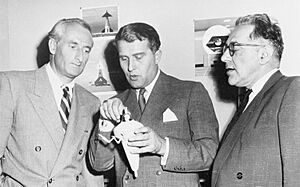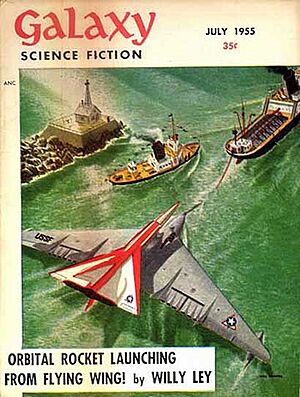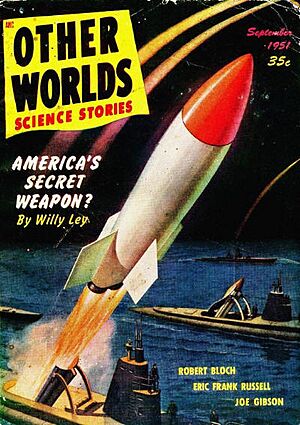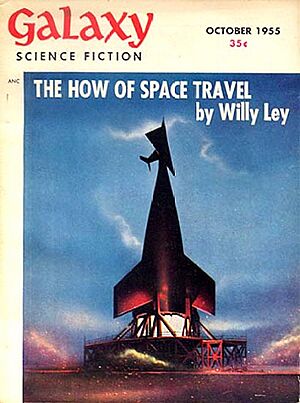Willy Ley facts for kids
Quick facts for kids
Willy Ley
|
|
|---|---|

(left to right) Heinz Haber, Wernher von Braun, Willy Ley
|
|
| Born |
Willy Otto Oskar Ley
October 2, 1906 |
| Died | June 24, 1969 (aged 62) |
| Other names | Robert Wiley |
| Occupation | science writer and historian of science |
| Spouse(s) | Olga |
| Children | daughters Sandra and Xenia |
| Notes | |
|
US citizen (1944)
Worldcon Guest of Honor (1953) |
|
Willy Otto Oskar Ley (born October 2, 1906 – died June 24, 1969) was a German and American science writer. He was a big supporter of space travel and also wrote about cryptozoology, which is the study of hidden or unknown animals. A crater on the far side of the Moon is named Ley in his honor.
Contents
Early Life and His Dream to Explore
Willy Ley was born in Berlin, Germany. His father was a traveling merchant, and his mother was a hatmaker. Willy grew up during the First World War. His father was stuck in Great Britain during the war, and his mother worked far away. So, Willy was mostly raised by his aunts.
Willy often said he grew up "in the shadow of the Museum of Natural History in Berlin." When he was asked what he wanted to be when he grew up, he said, "I want to be an explorer." His teacher thought this was a silly idea, but Willy was serious about it.
Studying Science and Space
At the University of Berlin, Willy studied many exciting subjects. These included astronomy (the study of stars and planets), physics (how things work), zoology (animals), and paleontology (fossils and ancient life). He was always looking into areas that others might have missed.
Willy became very interested in spaceflight after reading a book by Hermann Oberth called Die Rakete zu den Planetenräumen (The Rocket into Interplanetary Space). Even though it was a very technical book, Willy worked through it. He realized that outer space would soon be the next big area for humans to explore.
At just 19 years old, Willy wrote his own book to explain Oberth's ideas to more people. He also started writing to everyone he knew who was interested in rockets in Europe.
Joining the Spaceflight Society
In 1927, after publishing his book Die Fahrt ins Weltall (Travel in Outer Space), Willy became one of the first members of Germany's amateur rocket group. This group was called the Verein für Raumschiffahrt (VfR), which means "Spaceflight Society." He wrote many articles for their journal, Die Rakete (The Rocket). Willy even became the group's Vice-President. He also wrote hundreds of short articles about rockets for newspapers in Germany and other countries.
Thanks to Willy and other writers like Max Valier, Berlin saw a short "rocketry fad." People were excited about space travel and the idea of new "wonder weapons."
Rockets on the Big Screen
This excitement peaked with Fritz Lang's 1929 film Die Frau im Mond (Woman in the Moon). This movie was the first to show spaceflight in a realistic way. Willy Ley was a very important technical consultant for the film. He helped make sure the models of the spaceship, its paths, and orbits were very accurate. The director, Fritz Lang, later said that Willy's work was "amazing." In fact, the models were so accurate that years later, in 1937, the German secret police (the Gestapo) took away all models and foreign copies of the film.
Leaving Germany
As the Great Depression hit, public interest in rockets faded. Some rocket researchers started working more closely with the military. Willy became discouraged by this change and the need for secrecy. He continued to write articles and stayed in touch with friends. He also went back to his original science interests, even writing a book about Conrad Gessner, who is known as the "father" of modern zoology. To earn money, Willy also worked at a bank in Berlin.
Life became difficult for Willy when the Nazis came to power. He did not like their ideas or their violent way of doing things. He was also known internationally for sharing information about rockets. In January 1935, Willy used a company letter to get permission for a vacation in London. He left Germany with only his favorite books, some clothes, and travel papers. He went to the United Kingdom and then to the United States.
Life in the United States
In 1936, Willy Ley helped with an interesting project in Greenwood Lake, New York. He supervised two rocket planes that carried mail!
Willy loved reading science fiction stories. He started writing science articles for American science fiction magazines. His first article, "The Dawn of the Conquest of Space," appeared in Astounding Stories in March 1937. He even wrote a science fiction story himself, "At the Perihelion," using the pen name Robert Wiley.
Willy was also part of the science fiction fandom, which means he was a big fan and attended science fiction conventions. He was even a special guest at the 1953 World Science Fiction Convention.

In 1940, Willy joined the staff of PM, a newspaper. There, he met Olga Feldmann, a fitness columnist and model. They got married on Christmas Eve in 1941.
Writing About Space and the Future
Willy's book Rockets – the Future of Travel Beyond the Stratosphere (1944) described early rockets and future plans to reach the Moon. He even predicted a 3-stage rocket as tall as one-third of the Empire State Building. This was a very good guess for the height of the Saturn V rocket, which was designed 20 years later!
His books from the 1950s and 1960s are still considered important popular science books. Some of these include:
- The Conquest of Space (1949), with Chesley Bonestell
- The Conquest of the Moon (1953), with Wernher von Braun and Fred Whipple
- Beyond the Solar System (1964)
His book Rockets, Missiles, and Space Travel (1957) was even used by U.S. lawmakers to learn about spaceflight. Willy also wrote a regular science column called "For Your Information" in Galaxy Science Fiction magazine from 1952 until he passed away.
Willy Ley also helped explain spaceflight to a huge TV audience. He was part of "Man in Space," a 1955 episode of the Disneyland TV show. He also designed space vehicle models for Monogram models and wrote informational booklets for them. He advised on the Tom Corbett, Space Cadet children's TV series and books, and the 1959 film The Space Explorers. Famous science fiction writers like Robert A. Heinlein and Larry Niven even honored him by naming things after him in their books.
In 1954, Willy wrote Engineers' Dreams. In this book, he talked about "Seven Future Wonders of the World." He made accurate predictions about the Channel Tunnel between Britain and France, and using wind, solar, and geothermal power.
Willy Ley passed away on June 24, 1969, at the age of 62. This was less than a month before humans first landed on the Moon! He lived with his family in Jackson Heights, Queens, New York.
Cryptozoology: Exploring Unknown Animals
While Willy Ley was best known for his work on rockets and space, he also wrote books about cryptozoology. This is a field that looks into the possible existence of animals that are not officially recognized by science.
In 1949, Willy published an article called Do Prehistoric Monsters Still Exist? This article helped make the idea of living dinosaurs popular. It also talked about the legend of the Mokele-mbembe, a creature said to live in the Congo. Willy collected a lot of information about unusual animals for his writings.
See also
 In Spanish: Willy Ley para niños
In Spanish: Willy Ley para niños





